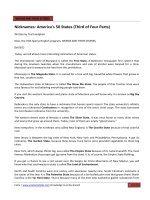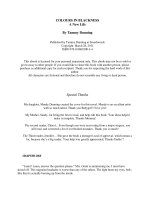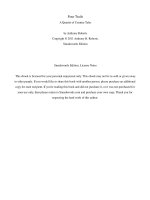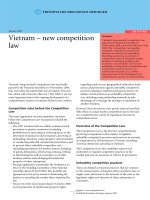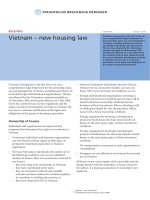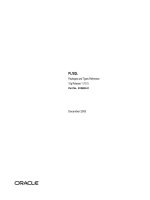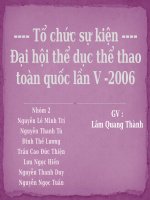Press Release Names Four New Elements 30November2016
Bạn đang xem bản rút gọn của tài liệu. Xem và tải ngay bản đầy đủ của tài liệu tại đây (161.32 KB, 3 trang )
Advancing Chemistry Worldwide
President
Prof. Natalia P. Tarasova (Russia)
Past President
Dr. Mark C. Cesa (USA)
Vice President
Prof. Qi-Feng Zhou (China)
Treasurer
Mr. Colin J. Humphris (UK)
Secretary General
Prof. Richard Hartshorn (New Zealand)
Executive Director
Dr. Lynn M. Soby (USA)
For Immediate Release 30 November 2016
IUPAC Announces the Names of the Elements 113, 115, 117, and 118
Elements 113, 115, 117, and 118 are now formally named nihonium (Nh), moscovium (Mc),
tennessine (Ts), and oganesson (Og)
Research Triangle Park, NC (USA): On 28 November 2016, the International Union of Pure
and Applied Chemistry (IUPAC) approved the names and symbols for four elements:
nihonium (Nh), moscovium (Mc), tennessine (Ts), and oganesson (Og), respectively for
element 113, 115, 117, and 118.
Following a 5-month period of public review, the names earlier proposed by the
discoverers have been approved by the IUPAC Bureau. The following names and symbols
are officially assigned:
Nihonium and symbol Nh, for the element 113,
Moscovium and symbol Mc, for the element 115,
Tennessine and symbol Ts, for the element 117, and
Oganesson and symbol Og, for the element 118.
In concordance with and following the earlier reports that the claims for discovery of these
elements have been fulfilled [1,2], the discoverers have been invited to propose names.
Keeping with tradition, the newly discovered elements have been named after a place or
geographical region, or a scientist. The ending of the names also reflects and maintains
historical and chemical consistency: “-ium” for elements 113 and 115 and as for all new
elements of groups 1 to 16, “-ine” for element 117 and belonging to group 17 and “-on” for
element 118 element belonging to group 18.[3] The recommendations will be published in
the IUPAC journal Pure and Applied Chemistry ( />For further information please see: www.iupac.org/iupac-announces-the-names-of-theelements-113-115-117-and-118.
IUPAC Secretariat P.O. Box 13757 Research Triangle Park, North Carolina 27709 USA
T+1 919 485 8700 F +1 919 485 8700 www.iupac.org
The name nihonium with the symbol Nh for element 113 was proposed by the discoverers
at RIKEN Nishina Center for Accelerator-Based Science (Japan); the name came from Nihon
which is one of the two ways to say “Japan” in Japanese, and literally mean “the Land of
Rising Sun”.
Moscovium with the symbol Mc for element 115 and tennessine with the symbol Ts for
element 117 were proposed by the discoverers at the Joint Institute for Nuclear Research,
Dubna (Russia), Oak Ridge National Laboratory (USA), Vanderbilt University (USA) and
Lawrence Livermore National Laboratory (USA). Both are in line with tradition honoring a
place or geographical region. Moscovium is in recognition of the Moscow region and honors
the ancient Russian land that is the home of the Joint Institute for Nuclear Research, where
the discovery experiments were conducted using the Dubna Gas-Filled Recoil Separator in
combination with the heavy ion accelerator capabilities of the Flerov Laboratory of Nuclear
Reactions. Tennessine is in recognition of the contribution of the Tennessee region of the
United States, including Oak Ridge National Laboratory, Vanderbilt University, and the
University of Tennessee at Knoxville, to superheavy element research.
Lastly, and in line with the tradition of honoring a scientist, the name oganesson and
symbol Og for element 118 was proposed by the collaborating teams of discoverers at the
Joint Institute for Nuclear Research, Dubna (Russia) and Lawrence Livermore National
Laboratory (USA) and recognizes Professor Yuri Oganessian (born 1933) for his pioneering
contributions to transactinoid elements research. His many achievements include the
discovery of superheavy elements and significant advances in the nuclear physics of
superheavy nuclei including experimental evidence for the “island of stability”.
Comments from the general public, during the 5 month period were many. Apart from
many full agreements, comments were received suggesting other names, in some cases
accompanied by petitions from large groups of people. However, these suggestions could
not be accepted, given the fact that under the current guidelines only the discoverers have
the right to propose names and symbols. Questions were also received about pronunciation
of the names and the translations into other languages. Members of the chemistry
community also raised the concern that Ts is one of the two commonly used abbreviations
for the tosyl group. Recognizing however that many two-letter abbreviations have multiple
meanings —even in chemistry, and for example Ac and Pr— the conclusion was made that
the context in which the symbols are used, makes the meaning unambiguous.
“Overall, it was a real pleasure to realize that so many people are interested in the naming of
the new elements, including high-school students, making essays about possible names and
telling how proud they were to have been able to participate in the discussions,” said
Professor Jan Reedijk, President of the Inorganic Chemistry Division. He added “It is a long
process from initial discovery to the final naming, and IUPAC is thankful for the cooperation
of everyone involved. For now, we can all cherish our periodic table completed down to the
seventh row.”
“The names of the new elements reflect the realities of our present time” said IUPAC
President Professor Natalia Tarasova, “universality of science, honoring places from three
continents, where the elements have been discovered—Japan, Russia, the United States—and
the pivotal role of human capital in the development of science, honoring an outstanding
scientist—Professor Yuri Oganessian”.
The exploration of new elements continues, and scientists are searching for elements
beyond the seventh row of the periodic table. IUPAC and the International Union of Pure
and Applied Physics (IUPAP) are establishing a new joint working group whose task will be
to examine the criteria used to verify claims for the discovery of new elements.
References:
[1] P.J. Karol, R.C. Barber, B.M. Sherrill, E. Vardaci, T. Yamazaki, Pure Appl. Chem. 88 (2016)
139; />[2] P.J. Karol, R. C. Barber, B. M. Sherrill, E. Vardaci, T. Yamazaki, Pure Appl. Chem. 88
(2016) 155; />[3] W.H. Koppenol, J. Corish, J. Garcia-Martinez, J. Meija, J. Reedijk, Pure Appl. Chem. 88
(2016) 401; online 21 Apr 2016; />About IUPAC:
IUPAC was formed in 1919 by chemists from industry and academia. Since then, the Union has
succeeded in fostering worldwide communications in the chemical sciences and in uniting
academic, industrial and public sector chemistry in a common language. IUPAC is recognized
as the world authority on chemical nomenclature, terminology, standardized methods for
measurement, atomic weights and many other critically evaluated data. In more recent years,
IUPAC has been pro-active in establishing a wide range of conferences and projects designed
to promote and stimulate modern developments in chemistry, and also to assist in aspects of
chemical education and the public understanding of chemistry. More information about
IUPAC and its activities is available at www.iupac.org.
For further information, contact Dr. Lynn M. Soby, Executive Director, IUPAC,
at or
